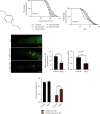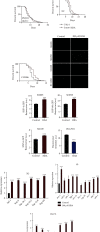Para-Hydroxybenzyl Alcohol Delays the Progression of Neurodegenerative Diseases in Models of Caenorhabditis elegans through Activating Multiple Cellular Protective Pathways
- PMID: 35401930
- PMCID: PMC8989581
- DOI: 10.1155/2022/8986287
Para-Hydroxybenzyl Alcohol Delays the Progression of Neurodegenerative Diseases in Models of Caenorhabditis elegans through Activating Multiple Cellular Protective Pathways
Abstract
The traditional Chinese medicine Gastrodia elata (commonly called "Tianma" in Chinese) has been widely used in the treatment of rheumatism, epilepsy, paralysis, headache, and dizziness. Phenolic compounds, such as gastrodin, para-hydroxybenzyl alcohol (HBA), p-hydroxybenzaldehyde, and vanillin are the main bioactive components isolated from Gastrodia elata. These compounds not only are structurally related but also share similar pharmacological activities, such as antioxidative and anti-inflammatory activities, and effects on the treatment of aging-related diseases. Here, we investigated the effect of para-hydroxybenzyl alcohol (HBA) on neurodegenerative diseases and aging in models of Caenorhabditis elegans (C. elegans). Our results showed that HBA effectively delayed the progression of neurodegenerative diseases, such as Alzheimer's disease, Parkinson's disease, and Huntington's disease in models of C. elegans. In addition, HBA could increase the average lifespan of N2 worms by more than 25% and significantly improve the age-related physiological functions of worms. Moreover, HBA improved the survival rate of worms under stresses of oxidation, heat, and pathogenic bacteria. Further mechanistic investigation revealed that HBA could activate FOXO/DAF-16 and SKN-1 to regulate antioxidative and xenobiotic metabolism pathway. HBA could also activate HSF-1 to regulate proteostasis maintenance pathway, mitochondrial unfolded stress response, endoplasmic stress response and autophagy pathways. The above results suggest that HBA activated multiple cellular protective pathways to increase stress resistance and protect against aging and aging-related diseases. Overall, our study indicates that HBA is a potential candidate for future development of antiaging pharmaceutical application.
Copyright © 2022 Yu Liu et al.
Conflict of interest statement
The authors declare that there is no conflict of interest.
Figures






Similar articles
-
Orientin Prolongs the Longevity of Caenorhabditis elegans and Postpones the Development of Neurodegenerative Diseases via Nutrition Sensing and Cellular Protective Pathways.Oxid Med Cell Longev. 2022 Feb 21;2022:8878923. doi: 10.1155/2022/8878923. eCollection 2022. Oxid Med Cell Longev. 2022. PMID: 35237385 Free PMC article.
-
P-hydroxybenzaldehyde protects Caenorhabditis elegans from oxidative stress and β-amyloid toxicity.Front Aging Neurosci. 2024 May 22;16:1414956. doi: 10.3389/fnagi.2024.1414956. eCollection 2024. Front Aging Neurosci. 2024. PMID: 38841104 Free PMC article.
-
D-chiro-inositol increases antioxidant capacity and longevity of Caenorhabditis elegans via activating Nrf-2/SKN-1 and FOXO/DAF-16.Exp Gerontol. 2023 May;175:112145. doi: 10.1016/j.exger.2023.112145. Epub 2023 Mar 20. Exp Gerontol. 2023. PMID: 36921677
-
The rhizome of Gastrodia elata Blume - An ethnopharmacological review.J Ethnopharmacol. 2016 Aug 2;189:361-85. doi: 10.1016/j.jep.2016.06.057. Epub 2016 Jul 1. J Ethnopharmacol. 2016. PMID: 27377337 Review.
-
The stress of misfolded proteins: C. elegans models for neurodegenerative disease and aging.Adv Exp Med Biol. 2007;594:167-89. doi: 10.1007/978-0-387-39975-1_15. Adv Exp Med Biol. 2007. PMID: 17205684 Review.
Cited by
-
Gastrodin Improves the Activity of the Ubiquitin-Proteasome System and the Autophagy-Lysosome Pathway to Degrade Mutant Huntingtin.Int J Mol Sci. 2024 Jul 14;25(14):7709. doi: 10.3390/ijms25147709. Int J Mol Sci. 2024. PMID: 39062952 Free PMC article.
-
Protective effect of Gastrodia elata Blume in a Caenorhabditis elegans model of Alzheimer's disease based on network pharmacology.Biomed Rep. 2023 Apr 12;18(5):37. doi: 10.3892/br.2023.1620. eCollection 2023 May. Biomed Rep. 2023. PMID: 37113386 Free PMC article.
-
Ethyl acetate extract of Gastrodia elata protects Caenorhabditis elegans from oxidative stress and amyloid β peptide toxicity.Exp Ther Med. 2023 Jul 7;26(2):405. doi: 10.3892/etm.2023.12104. eCollection 2023 Aug. Exp Ther Med. 2023. PMID: 37522064 Free PMC article.
-
Para‑hydroxybenzaldehyde against transient focal cerebral ischemia in rats via mitochondrial preservation.Exp Ther Med. 2022 Oct 11;24(6):716. doi: 10.3892/etm.2022.11652. eCollection 2022 Dec. Exp Ther Med. 2022. PMID: 36382091 Free PMC article.
-
4,4'-methylenediphenol reduces Aβ-induced toxicity in a Caenorhabditis elegans model of Alzheimer's disease.Front Aging Neurosci. 2024 May 30;16:1393721. doi: 10.3389/fnagi.2024.1393721. eCollection 2024. Front Aging Neurosci. 2024. PMID: 38872629 Free PMC article.
References
-
- National Pharmacopoeia Committee. Pharmacopoeia of People’s Republic of China . Beijing: Chemical Industry Press; 2015.
-
- Shizhen L. In: Compendium of Materia Medica: Bencao Gangmu . Luo X., editor. Beijing: Foreign Languages Press; 2003. ISBN 7119032607.
MeSH terms
Substances
LinkOut - more resources
Full Text Sources
Medical
Miscellaneous

